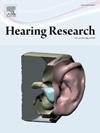中度噪声暴露后神经性和行为性双耳听力损伤及其恢复。
IF 2.5
2区 医学
Q1 AUDIOLOGY & SPEECH-LANGUAGE PATHOLOGY
引用次数: 0
摘要
噪声引起的耳蜗突触病已经研究了25年以上,但在人类中没有已知的诊断。这种类型的“隐性听力损失”导致内耳突触的损失,但听力阈值没有变化。最近的研究表明,在突触病诱发的噪音暴露两个月后,一些动物物种的突触可以再生。到目前为止,动物研究主要集中在外周听力的测量上,以诊断带状突触的丧失,同时表明双耳听力缺陷,如噪音中的语音接收,是由这种疾病引起的,但还没有考虑到突触可能的再生。为了解决这个问题,我们测量了雄性和雌性成年豚鼠在暴露于已被证明会诱发耳蜗突触病的噪音后的双耳生理和行为功能,后者利用声惊吓的预脉冲抑制方法。生理测量延长至噪声暴露后2个月,以表征任何缺陷和随后的恢复。虽然常见的听力学评估显示暂时的阈值移动,诱发电位振幅降低,表明突触病和可测量的双耳电生理听力缺陷,但所有测量都在2个月后恢复。暴露后2个月出现突触带再生,耳蜗组织学显示暴露后4个月无突触丢失。我们的研究结果表明,在先前的研究中被证明会导致突触丧失的噪声暴露方案会导致脑干的生理双耳处理缺陷,并且神经双耳处理的恢复与先前研究中显示的突触再生和正常的双耳听力行为相一致。本文章由计算机程序翻译,如有差异,请以英文原文为准。
Neural and behavioral binaural hearing impairment and its recovery following moderate noise exposure
Noise-induced cochlear synaptopathy has been studied for over 25 years with no known diagnosis for this disorder in humans. This type of “hidden hearing loss” induces a loss of synapses in the inner ear but no change in audiometric thresholds. Recent studies have shown that by two months post synaptopathy-inducing noise exposure, synapses in some animal species can regenerate. Animal studies to date have focused primarily on peripheral hearing measures to diagnose ribbon synapse loss, while suggesting binaural listening deficits such as speech-reception-in-noise result from this disorder, but haven't accounted for the possible regeneration of synapses. To address this, we measured binaural physiological and behavioral function, the latter utilizing the pre-pulse inhibition of acoustic startle method, in both male and female adult guinea pigs following exposure to noise that has been shown to induce cochlear synaptopathy. Physiological measurements extended to 2 months post noise exposure to characterize any deficit and subsequent recovery. While common audiological assessments showed temporary threshold shift, reduced evoked potential amplitudes indicative of synaptopathy and measurable binaural electrophysiological hearing deficits post exposure, all measures recovered by 2 months. Suspected regeneration of synaptic ribbons occurred by 2 months post exposure and cochlear histology revealed no synaptic loss 4 months post exposure. Our results show that the same noise exposure protocol demonstrated to cause synaptic loss in prior studies causes physiological binaural processing deficits in the brainstem and that the recovery of neural binaural processing coincides with the regeneration of synapses shown in previous studies and normal binaural hearing behavior.
求助全文
通过发布文献求助,成功后即可免费获取论文全文。
去求助
来源期刊

Hearing Research
医学-耳鼻喉科学
CiteScore
5.30
自引率
14.30%
发文量
163
审稿时长
75 days
期刊介绍:
The aim of the journal is to provide a forum for papers concerned with basic peripheral and central auditory mechanisms. Emphasis is on experimental and clinical studies, but theoretical and methodological papers will also be considered. The journal publishes original research papers, review and mini- review articles, rapid communications, method/protocol and perspective articles.
Papers submitted should deal with auditory anatomy, physiology, psychophysics, imaging, modeling and behavioural studies in animals and humans, as well as hearing aids and cochlear implants. Papers dealing with the vestibular system are also considered for publication. Papers on comparative aspects of hearing and on effects of drugs and environmental contaminants on hearing function will also be considered. Clinical papers will be accepted when they contribute to the understanding of normal and pathological hearing functions.
 求助内容:
求助内容: 应助结果提醒方式:
应助结果提醒方式:


